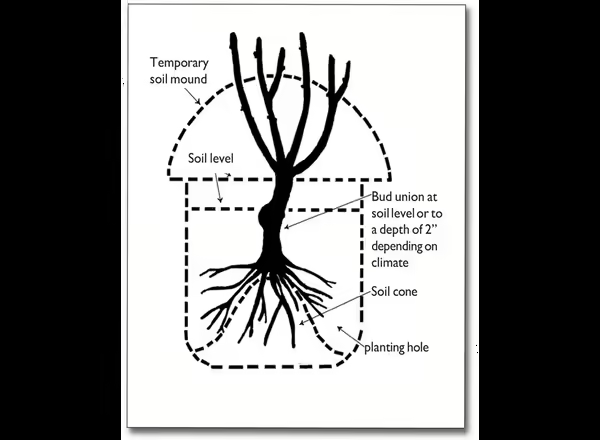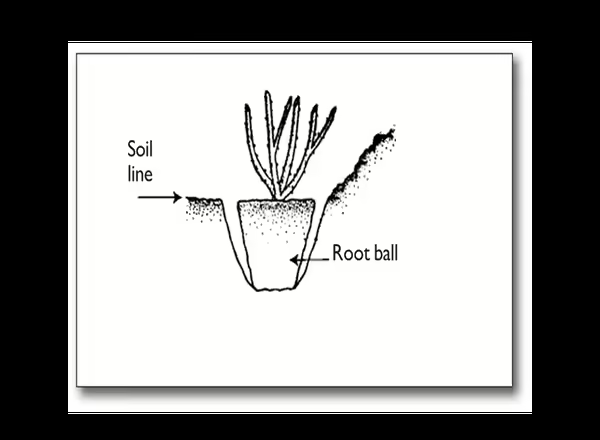
A general rule of thumb suggests that roses should be planted about 24 inches apart or a distance of about two-thirds of the expected height. This spacing will vary depending on the type of rose you are planting. Old garden roses will need wider spacing, while miniatures can be planted closer. Sufficient space between plants allows for good air circulation, an excellent first step in disease control.
When buying bare-root roses, try to schedule delivery as close to planting time as possible. In northern growing areas, roses can be planted as soon as soil can be worked in the spring. If the roses arrive early, check that the packing material is moist and keep them in a cool, dark place.
Before planting, soak bare-root roses in a bucket of water for 8-12 hours to help rehydrate the roots. The entire plant may be immersed to rehydrate the canes. After soaking, trim off any damaged or diseased roots. Botrytis, a grey mold, is a common disease found on the roots and canes of plants held in storage. To combat Botrytis, a common disease that may be found on bare root roses held in storage, the addition of a fungicide such as Daconil to the water may be helpful but not necessary.
Try to maintain 3-5 canes per plant, and each cane should be pruned back to 3-5 buds per cane. Any cane thinner than a pencil should be removed. Buds are easy to spot as raised oval areas on the cane. Roots may need additional pruning to remove damaged portions or to fit the planting hole. Also, if the plant has broken dormancy, prior to planting, trim any soft, succulent white shoots back to 1/8 inches.
Planting holes should be dug wide enough and deep enough to comfortably accept the roots of the plant. Set the plant so the bud union is at soil level. Fill the hole about 2/3 full of soil and add water, making a slurry of soil that gets between the roots. Do not tamp the soil, as this compacts it and destroys soil structure. After the water has drained down, add more soil and repeat the water fill process until the original soil level has been reached. Since the soil is loose, the plant will sink a little after planting, the bud union will end up 1-2 inches below soil level. This is where the bud union should be for roses growing in northern climates because this helps to provide some winter protection for the bud union.

The canes of dormant, newly planted bare-root roses need to be protected from drying winds and handled to encourage maximum bud break. To accomplish this, a temporary soil mound is placed over the canes to a depth of about 8-10 inches. This process is called "sweating" and is done to keep the canes moist to encourage maximum bud break. The soil is left in place for about 2-3 weeks or until new growth starts. When new growth does start, gently wash away the soil with a hose so as not to disturb the new growth. Other methods that work well are to wrap the canes in burlap that is kept moist or to mound the canes in sphagnum moss. Some rose growers use brown paper grocery bags to sweat their roses.
Place the bag upside down over the plant. Cut two slits in the top and anchor the bottom with soil. After growth starts, the bag can be removed slowly, first by increasing the size of the slits and then taking the bag off all together. Sweating is only done with newly planted bare-root roses. It is not done each spring. Don't use plastic bags for sweating. Heat buildup can cause injury or even death of the rose plant.

Potted roses are the easiest to plant because you have a plant that is already growing. Potted roses offer the flexibility of being ready for planting throughout the growing season. Potted roses bought early in the season may have most of the soil fall away from the roots when removing the pot. If so, plant as you would a bare root rose. If the potted rose is bought late in the season, the roots may have completely filled the pot and become entangled. If this is the case, be sure to loosen or cut these roots before planting. If you don't, the roots may continue to grow in a circular fashion and never spread out into the garden.
Roses are sometimes offered for sale in cardboard boxes labeled "plant them box and all." Experience shows that this practice often discourages quick rooting and establishment of the plant. There are two options for boxed roses. If the rose is planted in the spring and is still dormant, simply take it out of the box and treat it like a bare-root rose. If the plant has broken dormancy and is growing, cut the bottom off the box and set the rose in the hole at the proper depth. Then, cut through the sides of the box and carefully peel the box away. Refill the hole with soil and water.